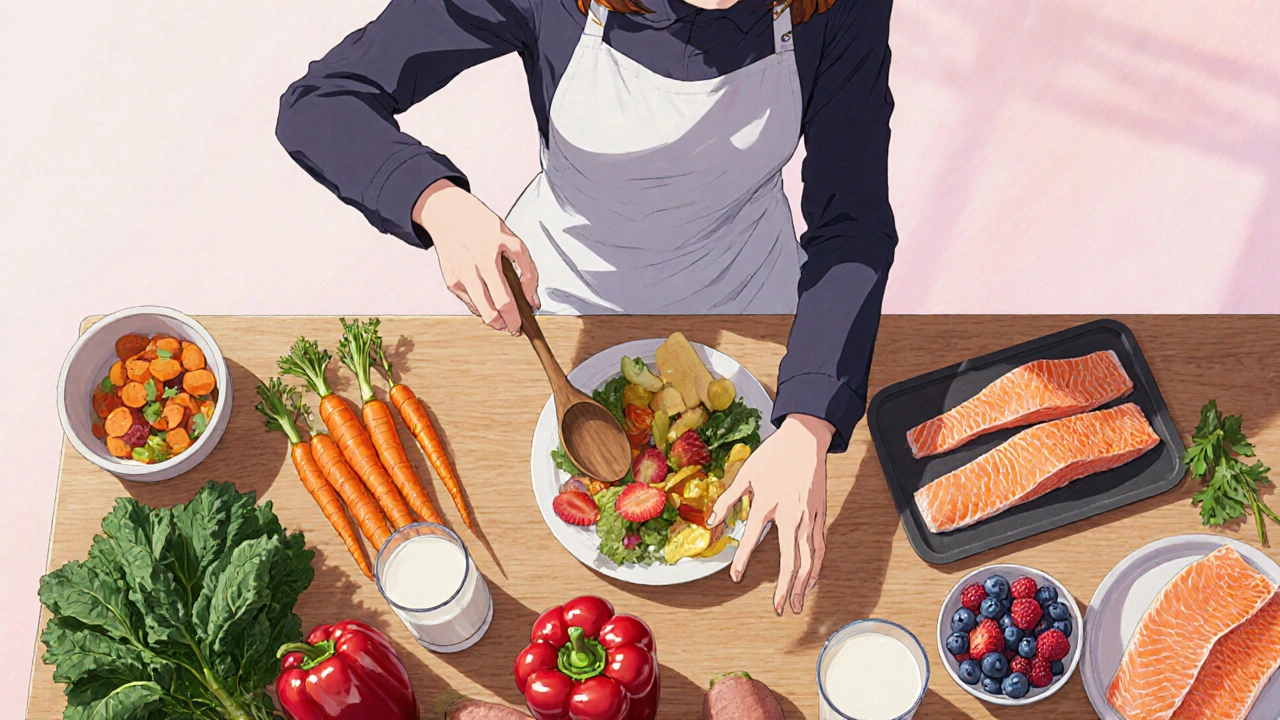Winter Vitamin D Calculator
Estimate your vitamin D needs during winter based on your sun exposure and diet. This calculator helps you understand if you might need supplements.
Tip: The article explains that winter increases vitamin D deficiency risk because of less sunlight exposure.
When the days get short and the temperature drops, it’s easy to let our nutrition slide. The lack of fresh produce, reduced sunlight, and a tendency to stay indoors all combine to raise the risk of prevent vitamin deficiency during the colder months. Below you’ll find a step‑by‑step plan to keep your micronutrient levels on track, no matter how gloomy the weather gets.
Why winter spikes the risk of vitamin deficiencies
Winter changes the way our bodies get and use nutrients in three key ways:
- Less sunlight means a drop in natural vitamin D production.
- Seasonal diets often lack fresh fruits and vegetables, cutting down on vitamins C, A, and B‑complex.
- Cold‑induced cravings for comfort foods can push calorie‑dense, nutrient‑poor options to the top of the menu.
Understanding these pressures helps you target the right nutrients before a deficiency shows up.
The vitamins most likely to dip in winter
Below are the micronutrients that typically take a hit once the sun goes down:
Vitamin D is a fat‑soluble vitamin that helps the body absorb calcium and supports immune function. It is primarily produced when skin is exposed to ultraviolet B (UVB) rays from sunlight.
Vitamin C is a water‑soluble antioxidant that protects cells from oxidative stress and boosts collagen production. It is abundant in citrus fruits, peppers, and leafy greens.
Vitamin B12 is essential for red‑blood‑cell formation and nerve health. Animal‑derived foods such as meat, eggs, and dairy are the primary sources.
Vitamin A supports vision, skin health, and immune response. Beta‑carotene‑rich foods like carrots, sweet potatoes, and pumpkin supply it.
Calcium works hand‑in‑hand with vitamin D to keep bones strong. Dairy, fortified plant milks, and leafy greens are common sources.
While iron and omega‑3 fatty acids aren’t vitamins, they often become deficient in winter diets, so we’ll address them too.
How to know if you’re slipping
Self‑assessment tools can spot red flags early:
- Watch for fatigue, muscle aches, or frequent colds-classic signs of low vitamin D or B12.
- Check for bruising, slow wound healing, or brittle nails; these may point to vitamin C or calcium gaps.
- Use a home testing kit for vitamin D levels. Many pharmacies sell finger‑prick tests that give a reliable read within minutes.
If you have chronic health conditions, talk to a GP about a full blood panel before the season peaks.

Winter food strategies that pack a nutrient punch
Building a winter‑proof diet is simpler than it sounds. Focus on three pillars: color, variety, and fortified foods.
| Vitamin / Mineral | Typical deficiency symptoms | Best food sources | Supplement dose (if needed) |
|---|---|---|---|
| Vitamin D | Bone pain, fatigue, frequent infections | Fatty fish, fortified milk, egg yolk | 800-2000 IU daily (consult doctor) |
| Vitamin C | Bleeding gums, slow wound healing | Citrus, kiwi, red bell pepper | 200 mg daily |
| Vitamin B12 | Weakness, tingling, anemia | Beef, salmon, fortified cereals | 25-100 µg daily (especially vegans) |
| Vitamin A (beta‑carotene) | Night‑vision problems, dry skin | Carrots, sweet potatoes, pumpkin | 5,000 IU twice weekly if diet lacks colour |
| Calcium | Muscle cramps, brittle nails | Yogurt, fortified soy milk, kale | 500 mg daily with vitamin D |
Make a habit of adding at least one orange‑coloured vegetable or a serving of fatty fish to each main meal. Frozen produce retains most of its vitamins, so stock up on frozen berries, peas, and spinach for quick soups and smoothies.
Smart supplementation: when and how
Supplements bridge gaps but aren’t a free pass to ignore food. Follow these rules:
- Targeted dosing: Take only the nutrients you’re missing; excess vitamin A can be toxic.
- Timing matters: Fat‑soluble vitamins (A, D, E, K) absorb best with a meal containing healthy fats.
- Quality check: Choose products certified by UK’s MHRA or verified by third‑party labs.
For most adults in the UK, a winter regimen of 1,000 IU vitamin D plus a multivitamin covering C, B12, and zinc suffices. If you’re vegan, add a B12 supplement of 25 µg daily and consider an algae‑based DHA source for omega‑3s.

Lifestyle tweaks that boost nutrient status
Beyond diet, a few habits can keep your micronutrient levels stable:
Sunlight exposure is the natural catalyst for vitamin D synthesis. Aim for 10-15 minutes of midday sun on face and arms, three times a week, even when it’s chilly.
- Take a brisk walk during lunch to soak up any daylight.
- Keep windows uncovered when possible; UVB can penetrate glass to a limited extent.
- Pair outdoor activity with a vitamin‑rich snack (e.g., an orange after a walk).
Regular moderate exercise improves circulation, helping nutrients reach cells more efficiently. Aim for at least 150 minutes of aerobic activity per week, supplemented by strength training twice weekly.
Quick winter‑deficiency checklist
- Do I get at least 10 minutes of midday sun three times a week?
- Does each main meal contain a source of vitamin C or a handful of leafy greens?
- Am I eating fatty fish or fortified dairy at least twice a week?
- Have I checked my vitamin D level with a home test kit?
- If I’m vegan/vegetarian, am I taking B12 and DHA supplements?
Ticking these boxes will dramatically lower the odds of winter‑related deficiencies.
Common questions answered
How much vitamin D do I need in winter?
The UK NHS recommends 10 µg (400 IU) daily for most adults, but many health professionals advise 20-25 µg (800-1000 IU) during winter, especially for people with limited sun exposure.
Can frozen vegetables replace fresh ones for winter nutrition?
Yes. Freezing locks in most vitamins and minerals. Choose plain frozen varieties without added sauces or sugars for the best nutrient retention.
Is it safe to take a high‑dose vitamin C supplement?
For most people, up to 2 g daily is well tolerated, but doses above 1 g can cause stomach upset. Stick to 200 mg-500 mg if you’re just filling gaps.
Do I need iron supplements in winter?
Iron deficiency isn’t tied to season as strongly as vitamins, but reduced meat consumption (e.g., holiday vegetarian meals) can lower intake. Test ferritin levels before supplementing, as excess iron is harmful.
What are the best plant‑based sources of omega‑3 for winter?
Ground flaxseed, chia seeds, and walnuts provide ALA, a precursor to EPA/DHA. For direct DHA/EPA, consider algae‑derived supplements, which are stable at room temperature.
By combining smart food choices, sensible supplements, and a bit of sunshine, you can keep winter from stealing your vitality.

Eli Soler Caralt
October 21, 2025 AT 18:50One must acknowledge that winter's dimming sun is not merely a meteorological inconvenience but a metaphysical affront to our cellular vitality 🌞✖️. The paucity of UVB photons orchestrates a clandestine decline in dermal vit D synthesis, leaving many unsuspecting souls adrift in a sea of sub‑optimal health. As the snowflakes settle, so too do the insidious deficits of vitamin C, A, and the B‑complex accumulate like unwelcome guests at a frosted banquet. Embrace the notion that each orange carrot and citrus slice is a rebellious act against the season's lethargy. Remember, the pursuit of micronutrient equilibrium is an art form, not a fleeting trend 😉.
Chirag Muthoo
October 22, 2025 AT 05:57It is essential to incorporate a balanced approach during the colder months, ensuring that each meal contains a source of essential vitamins. Regular exposure to natural daylight, even for brief periods, supports endogenous vitamin D production. Including fortified dairy or plant‑based alternatives can compensate for reduced sunlight. Moreover, consuming a variety of colorful fruits and vegetables supplies antioxidants and supports immune function. This systematic strategy promotes overall well‑being throughout winter.
Angela Koulouris
October 22, 2025 AT 14:17Think of your plate as a canvas and winter as the hush before a vibrant masterpiece. By sprinkling in kale, beetroot, and a splash of citrus, you paint health into each bite. Consistency is the brushstroke that turns good intentions into lasting vitality. Keep the colors vivid and the nutrients plentiful, and the season will feel less like a grey lull.
Harry Bhullar
October 23, 2025 AT 00:00When tackling winter nutrition, the first principle is to prioritize fat‑soluble vitamins with appropriate dietary fats, because without the lipid matrix, vitamins A and D remain largely unabsorbed. Start each main course with a drizzle of extra‑virgin olive oil or a handful of nuts to create that emulsified environment. Second, rotate your protein sources: oily fish such as salmon or mackerel thrice weekly supplies both vitamin D and omega‑3 fatty acids, while lean poultry and legumes provide B‑vitamins and iron. Third, frozen produce is a powerhouse; flash‑frozen berries retain anthocyanins, and frozen spinach preserves lutein and vitamin K. Fourth, fortify your breakfast with a fortified cereal or plant‑based milk; these often contain added vitamin D and calcium, making morning nutrition effortless. Fifth, schedule brief outdoor walks around noon to capitalize on any available UVB, even on cloudy days, because you never know when a brief sunburst will appear. Sixth, consider a vitamin D test kit early in the season; knowing your baseline guides supplementation dosage, preventing both deficiency and excess. Seventh, for vegans, a daily B12 supplement of 25‑100 µg is non‑negotiable, as plant foods lack reliable bioavailable sources. Eighth, calcium absorption is optimized when paired with vitamin D, so a latte made with fortified soy or almond milk can serve dual purposes. Ninth, watch for signs of fatigue, brittle nails, or frequent infections; they often signal a micronutrient gap that warrants a dietary tweak. Tenth, avoid excessive reliance on high‑sugar comfort foods, as they can impair nutrient absorption and promote inflammation. Eleventh, keep a simple log of your meals for a week to identify any recurring deficiencies. Twelfth, incorporate fermented foods like kefir or sauerkraut; they support gut health, which indirectly enhances nutrient utilization. Thirteenth, stay hydrated-cold weather can mask thirst, but adequate fluid intake is crucial for nutrient transport. Fourteenth, limit alcohol intake, as it can interfere with vitamin absorption and liver function. Finally, maintain a consistent exercise routine; aerobic activity improves circulation, ensuring that the nutrients you ingest reach every cell efficiently.
Dana Yonce
October 23, 2025 AT 02:47Vitamin D pills are cheap :)
Lolita Gaela
October 23, 2025 AT 08:20Utilizing a micronutrient stratification framework, one can align the pharmacokinetics of lipophilic versus hydrophilic agents to optimize bioavailability. For instance, the chelation dynamics of calcium carbonate necessitate an acidic gastric milieu, whereas cholecalciferol exhibits superior absorption when co‑administered with triglyceride‑rich matrices, thereby leveraging enterohepatic recirculation pathways. Incorporating phospholipid‑based emulsifiers can further augment the solubilization of fat‑soluble vitamers, mitigating first‑pass metabolic loss. These adjunctive mechanisms collectively amplify systemic retention rates, particularly pertinent during hypovitaminic winter intervals.
Giusto Madison
October 23, 2025 AT 12:30Listen, the science is clear-if you’re not syncing your vit D intake with proper lipid carriers, you’re basically throwing money down the drain. Stop babysitting your diet and start treating supplementation like a strategic operation. Align your meals, lock in the fats, and don’t be lazy about testing your levels. The only thing worse than a deficiency is a badly executed supplement plan.
erica fenty
October 23, 2025 AT 19:27Winter diets need a checkpoint; look at the macro‑micronutrient ratio, adjust accordingly; simple, effective, no fluff.
Xavier Lusky
October 23, 2025 AT 22:47What they don't tell you is that most of those "fortified" foods are just a way for big pharma to push unnecessary supplements onto the masses, keeping us dependent on their profit cycles while the real solution lies in natural sunlight and unprocessed foods.
Ashok Kumar
October 24, 2025 AT 01:00Ah yes, because the best way to stay healthy in winter is to distrust every piece of mainstream advice and live off the grid with a bag of carrots. Brilliant.